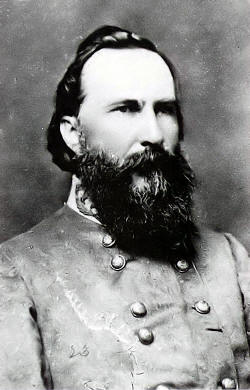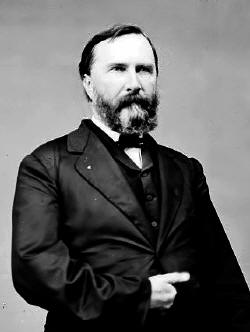|
This Site:
Civil War
Civil War Overview
Civil War 1861
Civil War 1862
Civil War 1863
Civil War 1864
Civil War 1865
Civil War Battles
Confederate Generals
Union Generals
Confederate History
Robert E. Lee
Civil War Medicine
Lincoln Assassination
Slavery
Site Search
Civil War Links
Civil War Art
Revolutionary War
Mexican War
Republic of Texas
Indians
Winslow Homer
Thomas Nast
Mathew Brady
Western Art
Civil War Gifts
Robert E. Lee Portrait
|
Confederate Generals
General James Longstreet
James Longstreet in Harper's Weekly
|
General James Longstreet BiographyBorn in Edgefield District, South Carolina, January 8, 1821, the son of a farmer, Longstreet spent his early years in Augusta, Georgia. On the death of his father he went with his mother to Somerville, Alabama. Corps commander James Longstreet made three mistakes that have denied him his deserved place in Southern posterity: He argued with
Robert E. Lee at
Gettysburg, he was right, and he became a Republican. He entered West Point from Alabama, graduated in 1842, and was wounded at
Chapultepec in
Mexico. With two brevets and the staff rank of major he resigned his commission on June 1,
1861, and joined the
Confederacy. His assignments included: brigadier general, CSA June 17, 1861); commanding brigade (in 1st Corps after July 20),
Army of the Potomac
July 2 - October 7, 1861);major general, CSA (October 7, 1861); commanding division, Ist
Corps, Army of the Potomac (October 14-22, 1861); |

General James Longstreet |
commanding division (in Potomac District until March 1862), Department of Northern Virginia (October 22, 1861 - July 1862); commanding lst Corps, Army of Northern Virginia July 1862 - February 25, 1863; May - September 9, 1863; April 12 - May 6, 1864; and October 19, 1864-April 9, 1865); lieutenant general, CSA (October 9, 1862); commanding Department of Virginia and North Carolina (February 25-May 1863); commanding his corps, Army of Tennessee (September 19-November 5, 1863); and commanding Department of East Tennessee (November 5, 1863-April 12, 1864). | |
Commanding a brigade, he fought at Blackburn's Ford and
1st Bull Run before moving up to divisional leadership for the Peninsula Campaign. There he saw further action at Yorktown, Williamsburg,
Seven Pines, and the Seven Days. In the final days of the latter he also directed
A. P. Hill's men. Commanding what was variously styled a "wing," "command," or "corps," the latter not being legally recognized until October 1862, he proved to be a capable subordinate to
Robert E. Lee at
second Bull Run, where he delivered a crushing attack.
He also saw service at South Mountain, Antietam, and
Fredericksburg. |
| |
 By now promoted to be the
Confederacy's senior lieutenant general, he led an independent expedition into southeastern Virginia where he displayed a lack of ability on his own. Rejoining
Lee, he opposed attacking at
Gettysburg in favor of maneuvering
Meade out of his position. Longstreet, who had come to believe in the strategic offense and the tactical defense, was proven right when the Confederate attacks on the second and third days were repulsed. Detached to reinforce
General Braxton Bragg in Georgia, he commanded a wing of the army on the second day at
Chickamauga. In the dispute over the follow-up of the victory he was critical of
Bragg and was soon detached to operate in East Tennessee. Here again he showed an incapacity for independent operations, especially in the siege of
Knoxville. Rejoining
Lee at the
Wilderness, he was severely wounded, in the confusion, by Confederate troops. He resumed command in October during the
Petersburg operations and commanded on the north side of the James. Lee's "Old War Horse" remained with his chief through the
surrender at Appomattox. By now promoted to be the
Confederacy's senior lieutenant general, he led an independent expedition into southeastern Virginia where he displayed a lack of ability on his own. Rejoining
Lee, he opposed attacking at
Gettysburg in favor of maneuvering
Meade out of his position. Longstreet, who had come to believe in the strategic offense and the tactical defense, was proven right when the Confederate attacks on the second and third days were repulsed. Detached to reinforce
General Braxton Bragg in Georgia, he commanded a wing of the army on the second day at
Chickamauga. In the dispute over the follow-up of the victory he was critical of
Bragg and was soon detached to operate in East Tennessee. Here again he showed an incapacity for independent operations, especially in the siege of
Knoxville. Rejoining
Lee at the
Wilderness, he was severely wounded, in the confusion, by Confederate troops. He resumed command in October during the
Petersburg operations and commanded on the north side of the James. Lee's "Old War Horse" remained with his chief through the
surrender at Appomattox.
After the war he befriended
Grant and became a Republican. He served as Grant's minister to Turkey. He also served as commissioner of Pacific Railroads under Mckinley and Roosevelt, from 1897 to 1904. Criticized by many former Confederates, he struck back with his book, From Manassas to Appomattox. He outlived most of his high-ranking postwar detractors. He died at Gainsville, Georgia, on January 2, 1904, the last of the high command of the Confederacy. He is buried in Gainsville. |
|

